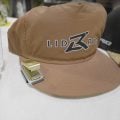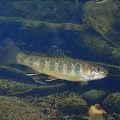How to Tie Just Another Euro-Jig
Producer: tightlinevideo
This is Just Another Euro-Jig. I started tying it almost exactly a year ago from what amounts to scraps on my tying bench. Since then it has worked quite well over a variety of conditions. I apologize to anyone who has come up with something similar and calls the pattern their own.
The fly starts with a Fulling Mill 5045 barbless jig hook. I like to get hold of the hook with plunger-style hackle pliers then stab an 1/8” nickel slotted tungsten bead with my bodkin. This helps me to get the small hole on the bead centered and exposed in the fingertips of my left hand which, in turn, makes it easy to insert the point of the hook into that hole. The bead’s then worked around the bend onto the shank before the assembly is firmly secured in the jaws of my tying vise. Do make sure that the squared-off end of the slot points down.
For thread, I’ve loaded a bobbin with a spool of UTC 140 in black. Get the thread started on the hook shank behind the bead and, after taking a few wraps rearward, advance your thread forward to the back edge of the bead, then snip off the excess tag.
.02 lead-free round wire is used to add weight, stabilize the bead and add some taper to the body of the fly. With the spool in hand, get hold of the bitter end and insert it into the back end of the bead, on top of the hook shank. Take 5 or 6 tight thread wraps to anchor the wire to the shank then bring the spool forward, behind your tying thread, and take 4 or 5 touching wraps rearward with the wire. Keeping the wire at 90 degrees to the shank, take a few wraps to secure it, then bring the wire over top of the shank and rock it up and down, as you take thread wraps. This will break it off and leave a little ramp down to the hook shank. Take thread wraps up and back over top of the wire to further secure it, ending with your tying thread hanging at about the hook point.
Dark or medium pardo Coq de Leon fibers are used for the tail of the fly. Pull 8-10 down, perpendicular to the stem, then pull the stem away to strip them free. This should keep the fiber tips nicely aligned. Measure to form a short little tail, only about a hook gap in length. Begin anchoring the tail to the top of the hook shank. Pulling up and slightly toward you on the fibers will ensure they land on top of the shank, as opposed to being pushed to the far side. Stop wrapping at the start of the hook bend, then advance your thread forward to behind the wire, and snip off the excess butt ends of the Coq de Leon fibers.
Small red Ultra wire is used to form a bright little tag on the fly. Get hold of one end and begin securing it to the hook shank, behind the wire wraps. Anchor it all the way back to just shy of the base of the tail. Start taking wraps with the wire, here too behind your tying thread. After 6 or 7 turns, anchor the wire to the top of the hook shank with thread wraps, before helicoptering the wire to break it off close.
Small-sized silver Ultra wire is used to rib and segment the abdomen of the fly, an 1/8” length will make numerous flies. Secure one end to the hook shank behind the wire wraps and anchor it all the way back to the start of the red wire. Then, advance your thread forward, once again, to the wire wraps.
Black Superfine dubbing is used to form the abdomen of the fly. Pull an ample clump free from the packet and use it to create a fairly slender 4” long noodle on your tying thread. Start taking wraps with the noodle so the dubbing begins right at the red wire. Continue taking touching wraps with the dubbing noodle to create a lightly tapered body on the fly.
Get hold of the silver wire and begin making open spiral wraps with it over top of the dubbed body, 4 turns showing usually looks pretty good. Anchor the wire with thread wraps and helicopter to break the excess off close.
Black Peacock Ice Dub is used for the thorax of the fly, the smallest wisp is all you need. Use the dubbing to create a short, slim noodle on your tying thread then take wraps with it to form a short, fuzzy collar at the back edge of the bead.
Reach for your whip finish tool and use it to do a 4 or 5 turn whip finish, seat the knot well and snip or cut your tying thread free. If there are any truly wonky fibers, now’s the time to snip them off. Get hold of your favorite head cement, here Sally Hansen Hard as Nails, and apply a liberal amount to the thread wraps at the back edge of the bead. Don’t neglect this step as, no matter how good your whip finish is, these wraps have a tendency to come undone.
And there you go, just another Euro-jig to add to your ever-expanding collection. Do make sure to let whatever adhesive you use dry thoroughly before fishing the fly.
How to Tie John Barr's Meat Whistle Streamer
How to Tie Kelly Galloup's Belly Bumper











